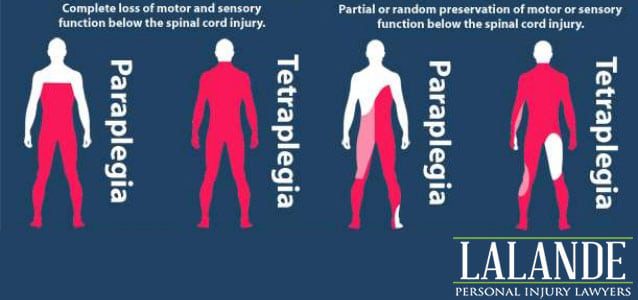Contents
Tetraplegia
What is it ?
Quadriplegia is characterized by involvement of all four limbs (two upper limbs and two lower limbs). It is defined by paralysis of the arms and legs caused by lesions in the spinal cord. The sequelae can be more or less important depending on the location of the vertebral damage.
It is about a motor impairment which can be total or partial, transitory or definitive. This motor impairment is generally accompanied by sensory disorders or even tone disorders.
Symptoms
Quadriplegia is a paralysis of the lower and upper limbs. This is characterized by an absence of movements due to lesions at the muscular levels and / or at the level of the nervous system allowing their functioning. (1)
The spinal cord is characterized by a network of communicating nerves. These allow the transmission of information from the brain to the limbs. Damage to this “communication network” therefore leads to a break in the transmission of information. Since the information transmitted is both motor and sensitive, these lesions not only lead to motor disturbances (slowing down of muscle movements, absence of muscle movements, etc.) but also sensitive disorders. This nervous network also allows a certain control at the level of the urinary system, the intestines or the genito-sexual system, these affections at the level of the spinal cord can lead to incontinence, transit disorders, disorders erection, etc. (2)
Quadriplegia is also marked by cervical disorders. These lead to paralysis of the respiratory muscles (abdominal and intercostal) which can lead to respiratory fragility or even respiratory failure. (2)
The origins of the disease
The origins of quadriplegia are lesions in the spinal cord.
The spine is formed of a ‘canal’. It is within this canal that the spinal cord is located. This marrow is part of the central nervous system and plays a fundamental role in transmitting information from the brain to all members of the body. This information can be muscular, sensory or even hormonal. When a lesion appears in this part of the body, the nearby nerve structures can no longer function. In this sense, the muscles and organs controlled by these deficient nerves also become dysfunctional. (1)
These lesions in the spinal cord can result from trauma such as during road accidents. (1)
Accidents linked to sports can also be the cause of quadriplegia. This is particularly the case during certain falls, during dives in deep water, etc. (2)
In another context, certain pathologies and infections are capable of developing an underlying quadriplegia. This is the case with malignant or benign tumors which compress the spinal cord.
Spinal cord infections, such as:
– spondylolisthesis: infection of one or more intervertebral disc (s);
– epiduritis: infection of the epidural tissue (tissues surrounding the marrow);
– Pott’s disease: intervertebral infection caused by Koch’s bacillus (bacteria causing tuberculosis);
– malformations linked to poor circulation of cerebrospinal fluid (syringomyelia);
– myelitis (inflammation of the spinal cord) such as multiple sclerosis are also a source of the development of quadriplegia. (1,2)
Finally, circulatory disorders, such as epidural hematoma resulting from treatment with anticoagulants or appearing after a lumbar puncture, by compressing the marrow, can be the cause of the development of paralysis of the four limbs. (1)
Risk factors
The risk factors associated with spinal cord trauma and the development of quadriplegia are, most commonly, traffic accidents and sports-related accidents.
On the other hand, people suffering from infections of the type: spondylolisthesis, epiduritis or an infection by Koch’s bacillus in the spine, subjects with myelitis, vascular problems or even malformations limiting the good circulation of cerebrospinal fluid, are more subject to the development of quadriplegia.
Prevention and treatment
The diagnosis must be made as soon as possible. Brain or bone marrow imaging (MRI = Magnetic Resonance Imaging) being the first prescribed examination to be performed.
The exploration of the muscular and nervous systems is carried out by a lumbar puncture. This allows the collection of cerebrospinal fluid in order to analyze it. Or the electromyogram (EMG), analyzing the passage of nerve information between nerves and muscles. (1)
Treatment for quadriplegia depends heavily on the root cause of the paralysis.
Medical treatment is often not sufficient. This paralysis of the four limbs requires muscular rehabilitation or even neurosurgical intervention. (1)
Personal assistance is often required for the person with quadriplegia. (2)
As there are many disability situations, care is therefore different depending on the person’s level of dependency. An occupational therapist may then be required to take charge of the subject’s rehabilitation. (4)










